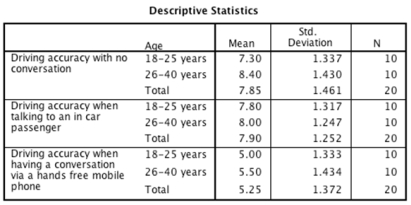Multiple Choice
An experiment was done to compare the effect of having a conversation via a hands-free mobile phone, having a conversation with an in-car passenger, and no distraction (baseline) on driving accuracy. Twenty participants from two different age groups (18-25 years and 26-40 years) took part. All participants in both age groups took part in all three conditions of the experiment (in counterbalanced order) , and their driving accuracy was measured by a layperson who remained unaware of the experimental hypothesis.
-What does the following output table tell us about the age variable? Tests of Between-Subjects Effects
Tests of Between-Subjects Effects
Measure: MEASURE_1
Transformed Variable: Average
A) If we ignore all other variables, the driving accuracy of participants who were between the ages of 18 and 25 years were similar to that of participants who were between the ages of 26 and 40 years.
B) If we ignore all other variables, participants who were between the ages of 18 and 25 years performed significantly differently than participants who were between the ages of 26 and 40 years.
C) Participants who were between the ages of 18 and 25 years were less accurate drivers than participants who were between the ages of 26 and 40 years.This was a large effect.
D) The decline in accuracy across the distraction groups was more pronounced for the younger drivers.
Correct Answer:

Verified
Correct Answer:
Verified
Q9: Field and Lawson (2003) reported the
Q10: An experiment was done to compare the
Q11: An experiment was done to compare the
Q12: An experiment was conducted to see how
Q13: An experiment was done to compare
Q14: A three-way ANOVA:<br>A)Is also known as a
Q15: An experiment was conducted to see how
Q16: An experiment was done to compare the
Q17: An experiment was conducted to see how
Q19: An experiment was done to compare the